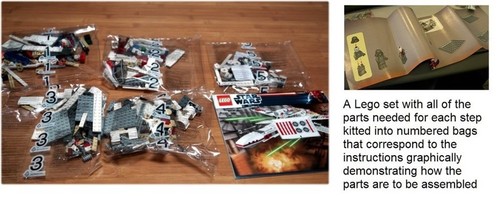See on Scoop.it – lean manufacturing “Not long ago I conducted an exercise with a client in which two teams of three people assembled a Lego product. One team of three folks from accounting was given the 500 or so pieces the way Lego presents them – kitted in bags of parts that align with the largely graphic instructions. Basically, all of the parts needed to make sub-assembly #3, for instance, are in a bag marked ‘3’, and the instructions for 3 show pictures of exactly how all of the parts are to be assembled…”
Michel Baudin‘s comments:
You can do many things with Legos, like our own Leanix™games, and this article shows an example where a team of accountants who were given parts in kits and assembly instructions from Lego performed 40% faster than a team of engineers who were given the parts in single-item bags and only pictures of the finished assemblies.
In drawing far-reaching conclusions from this example, however, Bill is comparing apples and oranges. It was faster to assemble from kits because somebody at Lego had kitted the parts, and the kits were complete and accurate. A fair comparison would require including the time needed for this. Kitting may still win, but not by a 40% landslide.
In a real manufacturing situation, you buy components and materials from specialized suppliers and, if you want kits, you have to put them together before assembly. Whether it is justified or not depends on what you are producing and on the parts you use.
Let us assume you are making custom-configured products on a mixed-flow line, but there is one screw that is used in all configurations. You are better off presenting this screw on the line side in bins than distributing it across kits.
On the other hand, it often makes sense to kit configuration-specific parts off line. It requires less labor overall but, most importantly, the work of kitting is done in parallel with assembly rather than in the final assembly sequence, which can cut in half the start-to-finish assembly time on the line.
Even then, however, you have issues with kitting errors by operators who don’t know the product, kits rendered unusable by a single defective part, and part stealing from kits, which is often done as an immediate remedy to the above.
Jan 14 2014
And around and around it goes | Bill Waddell
See on Scoop.it – lean manufacturing
 “Not long ago I conducted an exercise with a client in which two teams of three people assembled a Lego product. One team of three folks from accounting was given the 500 or so pieces the way Lego presents them – kitted in bags of parts that align with the largely graphic instructions. Basically, all of the parts needed to make sub-assembly #3, for instance, are in a bag marked ‘3’, and the instructions for 3 show pictures of exactly how all of the parts are to be assembled…”
“Not long ago I conducted an exercise with a client in which two teams of three people assembled a Lego product. One team of three folks from accounting was given the 500 or so pieces the way Lego presents them – kitted in bags of parts that align with the largely graphic instructions. Basically, all of the parts needed to make sub-assembly #3, for instance, are in a bag marked ‘3’, and the instructions for 3 show pictures of exactly how all of the parts are to be assembled…”
You can do many things with Legos, like our own Leanix™games, and this article shows an example where a team of accountants who were given parts in kits and assembly instructions from Lego performed 40% faster than a team of engineers who were given the parts in single-item bags and only pictures of the finished assemblies.
In drawing far-reaching conclusions from this example, however, Bill is comparing apples and oranges. It was faster to assemble from kits because somebody at Lego had kitted the parts, and the kits were complete and accurate. A fair comparison would require including the time needed for this. Kitting may still win, but not by a 40% landslide.
In a real manufacturing situation, you buy components and materials from specialized suppliers and, if you want kits, you have to put them together before assembly. Whether it is justified or not depends on what you are producing and on the parts you use.
Let us assume you are making custom-configured products on a mixed-flow line, but there is one screw that is used in all configurations. You are better off presenting this screw on the line side in bins than distributing it across kits.
On the other hand, it often makes sense to kit configuration-specific parts off line. It requires less labor overall but, most importantly, the work of kitting is done in parallel with assembly rather than in the final assembly sequence, which can cut in half the start-to-finish assembly time on the line.
Even then, however, you have issues with kitting errors by operators who don’t know the product, kits rendered unusable by a single defective part, and part stealing from kits, which is often done as an immediate remedy to the above.
See on www.idatix.com
Share this:
Like this:
By Michel Baudin • Blog clippings 0 • Tags: industrial engineering, Kitting, Lean assembly, part presentation